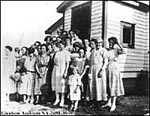 In the early 1900's, a number of women's groups evolved in Alberta. They participated in a variety of causes, from organizing local social and educational activities to promoting better healthcare and raising money for the war effort. The first groups were small local organizations, but soon, province- and nation-wide women's movements became active in Alberta. Among these groups were the Women's Christian Temperence Union
(WCTU) and the Alberta Temperance and Moral Reform League (AT&MRL).
In the early 1900's, a number of women's groups evolved in Alberta. They participated in a variety of causes, from organizing local social and educational activities to promoting better healthcare and raising money for the war effort. The first groups were small local organizations, but soon, province- and nation-wide women's movements became active in Alberta. Among these groups were the Women's Christian Temperence Union
(WCTU) and the Alberta Temperance and Moral Reform League (AT&MRL).
Each of these groups were strong advocates of prohibition and women's suffrage in Alberta. The United Farmers of Alberta also supported these goals. Both causes were interrelated. If women could achieve the franchise, they would vote overwhelmingly for prohibition. They were heavily influenced by the social gospel movement, which held that creating the right social conditions would bring an end to alcoholism, crime and other social problems. Many women believed that they could create the same conditions in public as they had in the home, if only they were empowered to do so.

In Alberta, the WCTU and AT&MRL helped achieve prohibition even before women were enfranchised. The Liberal government averted public pressure in 1913 by passing direct legislation by initiative and referendum . If these groups received enough signatures on a petition to legislate prohibition, they could force the government to hold a referendum on the issue. They accomplished this in 1915, after soliciting signatures from throughout the province. In the campaign that followed, the UFA and women's groups demonstrated the cost of drinking to society and the Alberta government. Opponents of prohibition included hotel and barkeepers, who benefited directly from the sale of liquor, and labour groups, whose members were mostly single men. While the anti-prohibition forces were very outspoken, the moral reformers were more widespread. On July 21, 1915, Alberta's all-male electorate voted sixty-one percent in favour of prohibition, and on July 1, 1916, the consumption of alcohol for beverage purposes was outlawed.

The prohibition campaign demonstrated to Albertans how influential women's groups had become. Some men were uneasy about women's newfound roles. Most Albertans, however, accepted women's importance to society and their greater role in political affairs. The UFA, in particular, recognized women's contribution to the settlement of Alberta and their potential usefulness in reforming the political system. To that end, they helped establish the UFWA in 1916.
It was
therefore an easier task to achieve women's suffrage. Premier Sifton, encouraged by the UFA and a huge delegation of women, introduced a Bill in 1915 to extend the same provincial rights and responsibilities to women as men. The Assembly voted almost unanimously in favour of the bill. On April 19, 1916, Alberta became the second
province, after Manitoba, to give most women the right to
vote .
Many women who had participated in the prohibition and suffrage campaigns rose to political prominence.
In 1916, Emily Murphy, a leader in the female suffrage campaign in Edmonton, was appointed Judge of the city's new Women's Court. She was the first female to become a magistrate in the  British Empire. Henrietta Muir Edwards, who had encouraged the WCTU to fight for female suffrage, became a respected authority on the legal status of women. Louise McKinney, president of the Alberta WCTU, represented the Non-Partisan League in Claresholm in the 1917 provincial election. She
became the first of two women to be elected to the Alberta Legislature. In the next election in 1921, feminist writer Nellie McClung won a seat for the Liberals in Edmonton, and UFWA president Irene Parlby was elected MLA for Lacombe. Parlby was also appointed Minister Without Portfolio, the second female to become a cabinet minister in the British Empire. These members of the "Famous Five" later fought to recognize women as persons under the Canadian constitution so that they could be appointed to the Senate.
British Empire. Henrietta Muir Edwards, who had encouraged the WCTU to fight for female suffrage, became a respected authority on the legal status of women. Louise McKinney, president of the Alberta WCTU, represented the Non-Partisan League in Claresholm in the 1917 provincial election. She
became the first of two women to be elected to the Alberta Legislature. In the next election in 1921, feminist writer Nellie McClung won a seat for the Liberals in Edmonton, and UFWA president Irene Parlby was elected MLA for Lacombe. Parlby was also appointed Minister Without Portfolio, the second female to become a cabinet minister in the British Empire. These members of the "Famous Five" later fought to recognize women as persons under the Canadian constitution so that they could be appointed to the Senate.
The WCTU, AT&MRL
and other women's groups had considerable influence over Alberta's legislation. Prohibition, although it proved to be too difficult to enforce, lasted until 1923 in Alberta. Many other reforms first championed by women's groups have endured to this day. Among these reforms was women's suffrage, which led to the opening of further opportunities for women to participate in politics.
Click
here to learn more about the Famous Five and the famous
"Persons Case"!




 Heritage Community Foundation Presents
Heritage Community Foundation Presents







